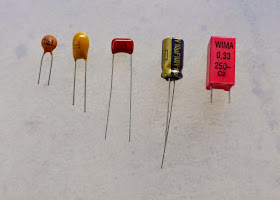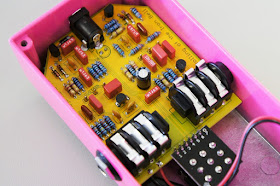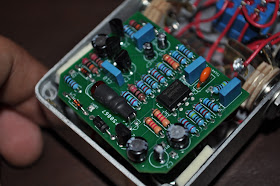If you step on it, it hurts! Just kidding, it seriously works like Legos as well! 😃
You have to choose different bricks (the electronic components: resistors, capacitors, diodes, IC...) and to assemble all of them following a schematic.
The only problem is: like there are different colors for the lego bricks, electronic components are declined in various versions, with the same value.
For instance, many many different capacitors can be found with the same capacitance value: Panasonic SMF, Wima MKP2, FKP2, MKT standard... What a mess! Lets try to make order in all of this, and to see which capacitors are best suited for our use (guitar pedals).
The 6 elements of capacitors
There are globally 6 main types of capacitors: electrolytic, ceramic, film, tantalum, polystyrene and silver-mica capacitors.The type of the capacitor is simply a description of what it is made of.
You should also look up for the capacitor working voltage (more on that in a bit). The tolerance of a capacitor is the maximum difference between a capacitor theoritical value and its real value. You should always look for that too; some capacitors can have tolerance values as huge as 40%!
The smaller the tolerance, the better. 😊
Here are a few examples of through-hole capacitors. From left to right: 150pF ceramic capacitor, 1uF tantalum capacitor, 10nF Panasonic SMF film capacitor, 10uF Panasonic FC electrolytic capacitor and a 0.33uF Wima MKP2 film capacitor.

Lets start:
- Electrolytic capacitors: they are cylindric. They usually have high capacitance value, so I would advise to use this kind of capacitors for any value above 1uF.
They also are polarised most of the time, so beware with the orientation. A good model which I use a lot is the Panasonic FC serie: top quality and a nice black and gold look! - Ceramic capacitors: they are used for small capacitance value, around 10-500pF. They are not very appreciated by audiophiles, because they do not let pass some bass frequencies: they work as a high pass filter at 100Hz.
If you make your guitar signal goes through this kind of capacitor without any alternate solution (another capacitor in parallel for instance), you will loose bass. However, when placed at strategic points of the circuit, they are very practical to choose how many trebles you want to go through. Usually, they have a high tolerance, so I recommand to look after models with a low tolerance. - Film-mica capacitors: they are used for low values like pF like ceramics. They are better than the ceramics, however, they are much bigger and more expensive. I would advise you to stay with the ceramics and save money!
- Tantalum capacitors: drop-shaped capacitors, used for values around uF. They are not very good for audio, and quite expensive. The only advantage compared to other capacitors of the same values (electrolytics, film caps) is the space saving. Sometimes, their defects in audio can be useful to create a harsh sound good for some kind of dirty fuzz like big muff (for instance, the black arts toneworks pharaoh fuzz uses tantalum capacitors)
My 2 cents about tantalum capacitors:
Tantalum capacitors are great because they are so small, so they are use in many electronics devices like your phone or computer. However, they are many ethical problems with coltan (the mineral used to make tantalum) mining, with human rights violations. More infos here. I try not to use tantalum caps because of that.
Tantalum capacitors are great because they are so small, so they are use in many electronics devices like your phone or computer. However, they are many ethical problems with coltan (the mineral used to make tantalum) mining, with human rights violations. More infos here. I try not to use tantalum caps because of that.
- Film capacitors: our favorites! Their value is in a large range from nF to 1 uF. You will use this kind of capacitors a lot! Moreover, most of them are really good for audio applications: MKP2 from Wima are a reference in the audio world. Panasonic SMF ECQ are also great, and have an easier-to-work-with shape with long lugs. Finallys, MKT standards are also quite good, and cheaper.
Here is a table to know which capacitor to use:
| Value | Capacitor type | Examples |
|---|---|---|
| 10-1000pF | Ceramic, Silver-Mica | Vishay ceramic caps, military grade ones are nice too |
| 1nF-1uF | Film | Wima MKP2, MKS2, Panasonic SMF |
| 1uF and more | Electrolytic | Panasonic FC |
What about the working voltage?
The working voltage is the maximum voltage a capacitor can accept.If you go above this voltage, your capacitor can be damaged! It is thus very important to use a tolerance which fits our usage.
In guitar pedal, we rarely use a voltage above 18V. So any capacitor with a tolerance above 18V is good.
Generally speaking, the bigger the tolerance value, the better.
Beware! With bigger working voltage also comes a bigger capacitor size. Electrolytic capacitors in particular can be HUGE! So always check the capacitor size as well.
Examples of capacitors in commercial pedals
Lets review a few pedals that some of you migh already have on your pedalboard! I will show you the guts of a few commercial pedals, and you will see what kind of capacitors they use.Mojo Hand Iron Bell (Big Muff inspired fuzz):

Fulltone OCD (overdrive / distortion)

Here, we can see lots of ceramic capacitors (blue "drops" everywhere on the circuit, and brownish round caps), and 2 electrolytic capacitors (black cylinders on the top of the circuit).
Bearfoot Pale Green compressor

Finally, in this Bearfoot pedal, we can see one tantalum capacitor (orange drop on the left of the circuit), MKT capacitors, probably Epcos brand (blue boxes), electrolytic capacitors of different sizes (small and big black and white cylinders). Good stuff here too!
If you liked this article, thank me by liking the Coda Effects facebook page! You can also follow Coda Effects on Instagram.
Any questions? Suggestions? Post a comment!To go further
- Good post about capacitors on European circuits blog.
- Nice piece of infos on byoc electronics about capacitors (pdf)

This comment has been removed by a blog administrator.
ReplyDeleteThere are 3 "kinds" of capacitors I've seen on the madbean PCB layout drawings: Circular, Rectangular, and Ellipse. What does this signify when it comes to the kind of cap to use? I'ven't seen this information.
ReplyDeletehomepage
Generally speaking, circular are for electrolytics capacitors (sometimes tantalum, but it should be specified in the build doc; 99% of the time, it is for electrolytic caps), rectangular are for film capacitor like Wima capacitors. Finally ellipse shapes can be used for ceramic capacitors, but also some film capacitors with different shapes like Panasonic SMF. Everything should be specified in the build doc though. Hope that it helps!
DeleteSorry if I missed it, but what do you recommend in place of a tantalum capacitor? I never knew all that about what goes into making tantalum, so I too would now like to avoid it!
ReplyDeleteExample - the Aion Refractor (Klon) recommends a 1uF tantalum cap. What could I use in place of that? Simply an electrolytic? Or, film? (I know tantalum are polarized, so maybe not film then?)
First, try to look where the capacitor is located. If it is located on the signal path, I would recommend a film capacitor over an electrolytic. But both can do the job perfectly fine :)
DeleteI would recommend an electrolytic for the Aion Refractor as it is smaller than a 1uF film cap.
Thanks Benoit! One other question, though it's not capacitor related... what are your thoughts about using diodes from Tayda? I saw your article about parts suppliers along with the pros and cons, but I'm not sure where diodes sit in that picture. Are they closer to a pot, where it is mostly standard, or is it more like a capacitor where investing in better quality is suggested?
DeleteI think for classic silicon diodes, it is not that important to pick the high quality one. It is very standard component, and even high quality ones cost almost nothing when bought in bulk.
DeleteI recently bought 1,000 Fairchild 1n4148 diodes that were around 0.01$ each!
So, in my opinion, you can go with Tayda regarding diodes.
Alright, thanks! I love your site by the way. As a beginner pedal DIYer, this site is extremely helpful!
DeleteI am pretty sure that the blue caps on the fulltone are not tantalum, but rather multi layer ceramic capacitors, which are more than fine due to it is size and better performance than regular ceramic caps.
ReplyDeleteYou are absolutely right! Old post, I did not have enough experience with ceramic capacitors back then. I will correct the post (I also noticed that a picture is missing)
DeleteHey, nice article.
ReplyDeleteHowever you first write that the lower the tolerance the better (on capacitance values) and then the contrary (on voltage tolerance). I know what you mean but this can get confusing.
Also the orange tantalum cap is on the right of the pic, not left.
Have you planned to write an article on how to choose the values? For decoupling, for filters...? This would be more technical and complicated, but surely very interesting for the circuit designer around here.
Keep up the good work!
Ok I will write it clearly somewhere!
DeleteGood idea to write the blog post about values
Great stuff ..about to order some boards
ReplyDeleteGreat article!
ReplyDeleteI'm wondering are there any differences in sound quality if you use a film capacitor out of polyster instead of a mkt one?
I'm working on a pedal that needs a 18nf capacitor and the only ones I can find are polyster "greenies".
you are clear my mind actually after reading your article i got clear my complete doubt. thanks for such easy understanding post.
ReplyDeleteJames clark @ electrotopic.com
If a ceramic and film cap share the same size / rating / value.... Are they interchangeable if the same size? A tiny ceramic 104 or a larger film with the same number stamped on it?... .
ReplyDeleteTolerance does not mean "the voltage the capacitor will tolerate." It means the percentage difference from the specified value that the part will fall between. For example, a 1 uF capacitor in 10% tolerance will actually measure between 0.9 uF and 1.1 uF.
ReplyDeleteMaximum Working Voltage is the specification that you are describing.
There are many different ceramic cap formulations. Most are NOT "audio worthy" as far as non-musical distortion they produce, and why ceramics in general have a bad rap. Most people just put all ceramics under the classification and this is totally wrong. The good ones are Class 1 COG/NPO are the only Class 1. They may be listed like this or just COG or just NPO, they are all the same. These are excellent audio quality, used to be much larger than the others, but with multilayer versions now available, high performance in small package. The next best would be the X7R Family (X8R, X7r, X6R, X5R). These are "minimally" acceptable for guitar audio, but totally not acceptable at all for high end HiFI or studio quality gear. The next worst and totally unacceptable to audio IMHO is Z5U, and even worst are Y5U. So please do not confuse the different ceramic types as the same, they are not, they are far from that. So ceramic capacitors can very in audio quality even greater than the difference between the High quality films and tantalums! FYI - not all films are the same, although all are "audio acceptable", Polystyrene, polypropylene, Teflon being the best, Polyester, polycarbonate and others being the lesser. A good way to test a ceramic capacitor to see if it is Audio quality or not is to measure capacitance with a capacitance meter, then heat the capacitor with a heat gun. If the capacitance changes and gets worse & worse as it gets hotter & hotter, throw it in the trash.
ReplyDelete